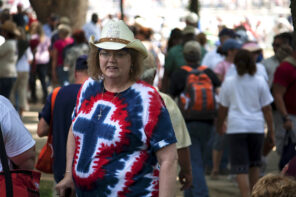In a much talked-about Op-Ed in Time last week in the wake of the Supreme Court’s ruling on same sex marriage, Rod Dreher wrote that Christians “really have to accept the fact that we really are living in a culturally post-Christian nation.” (Never mind the fact Anthony Kennedy, who wrote the soaring conclusion to the decision, is Catholic, and a former altar boy.)
In the piece, Dreher refers what he calls the “Benedict Option,” an idea he first wrote about in 2013 for the American Conservative. In the past couple of months, Dreher has evoked the Benedict Option in 17 blog posts, arguing each time, just as he did in that first essay, that America is entering a new “dark age,” brought about by “rising hedonism, waning religious observance, [the] ongoing break-up of the family, and a general loss of cultural coherence.”
Saint Benedict, according to Dreher, fled Rome out of “disgust for the city’s decadence,” and went on to establish a dozen monasteries, where the Benedictines “built lives of peace, order and learning,” but also taught nearby peasants “practical skills, like farming,” while educating those same peasants in the Christian faith.
Dreher’s model of what a modern monastic community would look like is based on several small communities of traditional Catholics and Orthodox Christians (Dreher himself is a former Catholic who converted to Orthodoxy), who have left urban and even suburban life behind to pursue homesteading, homeschooling, and attempting to preserve their children’s faith. These children are “largely disconnected from mainstream American popular culture,” and, according to a parent of one of these families, their “relative isolation makes the mission of forming the children’s character easier.”
Dreher acknowledges that the long-term viability of these small communities is unknown, but what becomes clear as he revisits this topic again and again in recent months is that conservative religious reaction to mainstream culture is symptomatic of a fear of change. Public school curriculum, marriage equality and the growing acceptance of transgender individuals are just a few of the topics Dreher has connected to his arguments for conservative Christians dropping out of American culture in much of his recent writing.
Even if Christians do not embrace the Benedict Option en masse, what its premise of retreat says about the pessimistic mood in American Christianity right now is telling.
Dreher has only commented briefly in his blogs on the Pew Survey’s data about the rapidly growing number of religiously unaffiliated younger adults, saying that “Christians don’t underestimate the difficulty of the road ahead,” and that they must “prepare.” But running throughout his and other’s growing commentary on the Benedict Option is a real sense of anxiety about what will happen to the kids.
Amish communities experience a high rate of retention of young adults partially because those children grow up in isolation from secular culture. The Duggars are but one example of fundamentalist Evangelical families that have also been able to keep their children attached to religion by emphasizing a family’s religion as a structure of authority, with a strict parent at the helm. But outside of those extreme examples, a larger sense of weakening ties to institutional religions means that it is increasingly a challenge to keep children interested in faith.
The Benedict Option’s emphasis on withdrawal is Dreher’s solution.
While statistics about the number of families who homeschool for religious reasons can be hard to find, it’s clear that beyond Dreher’s own Orthodox and Catholic examples, homeschooling, homesteading and a return to agrarian lifestyles—mostly lived out in deeply isolated areas—remain a topic of interest in many Christian communities. A cursory Google search for “Christian homeschooling” or “Christian homesteading” will yield thousands of results.
But here a question arises. Dreher refers to this notion of dropping out and building small religious communities as the Benedict Option, so how much of this has to do with the form of life that Saint Benedict originally intended? Fr. Anthony Ruff, a Benedictine of Saint John’s Abbey in Collegeville, Minnesota, says that “the Benedictine tradition has been quite rich and diverse from the beginning, and very early on in the middle ages monks served as missionaries and teachers.”
Ruff’s own community “came to the US in the 19th century primarily to serve immigrants as teachers and pastors, and that work almost came before their community prayer life at times.” Ruff adds that if he understands Dreher (whose work he follows and enjoys) correctly, “by the Benedict option he doesn’t mean complete isolation, but withdrawal for the sake of stronger identity to be able to engage the surrounding culture more convincingly.”
Of modern-day Benedictines, Ruff says, the definition of this withdrawal is not universal, since
“their opinions range from liberal progressivism on one side, which is open to dialogue with contemporary society and would like the church to be reformed as a result, to conservative traditionalism on the other side that thinks things went too far after Vatican II and we need more Latin chant and Catholic identity, and everything in between! It’s an interesting mix – and it’s ever been thus in terms of diversity of opinion.”
Dreher, who is in his late forties, may also have a different idea of what religious withdrawal would look like, and why people would choose it, than a younger person would. Emily,* a graduate student in theology, grew up in a religious group that “has some culture-suspecting, fundamentalist tendencies.” She converted to Catholicism in her late teens, but even after her conversion, she says that it is still hard to resist ideas about religion as a form of social withdrawal “because of how much of my life was characterized by it.”
In college, when a friend joked that she was “grumpy and misanthropic enough that I would probably enjoy the experience [of monastic life], Emily “realized that he was right. My immediate reaction was that maybe a cloistered community was something that I should consider as a vocation.”
Emily communicated with a cloistered order of Dominican women, but ultimately decided against that form of life. She was working in an intercultural ministerial context, and found that a diversity of “human cultures and means of interaction with one another, even in a purely non-religious way, were incredibly important for developing relationships.” She adds that “for any true injustices that I did see around me that really were against Christianity, it seemed that the best way I knew was not to avoid them and pretend those injustices would disappear.”
For Emily, cloistered life also seemed antithetical to her readings of the Gospels, which do include a few passages about Christ praying alone, but ultimately, for her, “the very idea of the incarnation was a kenotic self-emptying for the sake of encounter with others, despite whatever problems might accompany that.” Today, she says, she sees a necessity for people to withdraw to “liturgies and prayer communities” to help maintain faith in difficult circumstances, but, like an increasing number of younger Americans, she often finds friendship and spiritual kinship among “those who aren’t Catholic or even religious in any way.”
The homeschooling parents I spoke to had a range of reasons for choosing to educate their own children. Most cited a poor quality of education in their local public schools, but others echoed some of Dreher’s ideas about withdrawal as a reaction to what feels like a shift toward the secular in public space. One Catholic parent says that while she feels God has called her to take the formation of her children’s “minds and hearts” seriously, she is still open to sending them to school eventually.
She adds, however, that when secular education “cannot speak of God, wonder about Him, see His Hand in the world, in history, in our individual lives, something beautiful in us is silenced, and really, censored.” A product of public education herself, she admits that many of her teachers did “make room for possibilities” about religion, but that increasingly, “in some places this is no longer the case, and a certain tyrannical way of presenting things is coming into place.”
It is unclear whether the Benedict Option will help parents to keep their children faithful. Given the statistical number of Nones among Millennials and Gen X and the seemingly unpreventable increase in those numbers, these children, like Emily, or the children of many homeschooling parents, will eventually encounter peers who are not religiously affiliated. Given the way technology works, they will also inevitably find a way to expose themselves to popular culture.
And the question remains of the Benedict Option what exactly a parent should do if their family has withdrawn from “the world” and still turns out to have a gay child, a gay neighbor—or even a gay priest.
Perhaps what Dreher and his supporters are missing out on is the fact that Christianity, like our ideas about marriage, is not static, but may evolve along with our humanity. And that evolution may not only include a new openness to relationships, but also to Christians’ relationships with the growing number of Nones.
Christians who self-isolate will miss out on the opportunity to know, learn from, and perhaps even to love some of the Americans who have thought the hardest and longest about religion and its role in their lives. Jesus, after all, did not lead his disciples away from the people and their questions, and their messy, real lives, and doubts. He walked toward the people, not away from them.
*Last name withheld at subject’s request





